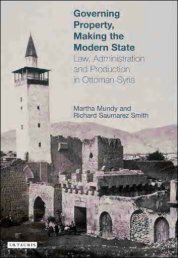The Young Turk Period, 1908-1918 - PSI424
The Young Turk Period, 1908-1918 - PSI424
The Young Turk Period, 1908-1918 - PSI424
You also want an ePaper? Increase the reach of your titles
YUMPU automatically turns print PDFs into web optimized ePapers that Google loves.
286 <strong>The</strong> Rise of Modern <strong>Turk</strong>ey, 1808-1975<br />
Table 4.1. Ottoman revenues and expenditures, <strong>1908</strong>-1911<br />
Total collections Percent of Expenditures<br />
Fiscal year (kurus.) assessment (kurus.) Balance (kurus,)<br />
1324/<strong>1908</strong>-9 2,519,791,592 92.16 n.a. n.a.<br />
1325/1909-10 2,692,693,836 96.44 2,775,263,363 -82,569,527<br />
1326/1910-11 2,878,303,078 98.14 3,374,511,319 -496,208,241<br />
Source: Ihsaiyat-t Maliye, vols. I, III, especially I, 402-433.<br />
and organizers were to be executed. <strong>The</strong> families of those participating in such<br />
bands also were subject to punishment, and their property could be confiscated<br />
by the state. <strong>The</strong> army was ordered to establish "pursuit battalions" to capture<br />
and disarm the terrorist bands, and all subjects were required to report the<br />
presence of such groups and to cooperate with the army's efforts against them. 38<br />
A Law on Public Gatherings required that permits be obtained to hold any public<br />
gathering, indicating the time and place, the subjects to be discussed, and the<br />
names of its sponsors, so that they would be available for punishment if the<br />
law was violated. No public gatherings could be held within 3 kilometers of<br />
the Porte or Parliament while they were in session. Gatherings could not disturb<br />
the regular flow of traffic in the public thoroughfares or sidewalks. Government<br />
officials had to be admitted to all gatherings so that they could ascertain that the<br />
law was being observed. 39 <strong>The</strong> Societies Law provided for the registration of all<br />
associations and also prohibited the formation of groups based on nationality or<br />
race or which advocated action to violate the law or public morality, disturb public<br />
order, or attack the empire's unity. 40 A new Press Law more or less confirmed<br />
those of Abdulhamit, making each newspaper legally and financially responsible<br />
for publishing information that might disturb public order, harm individuals, or<br />
incite violations of the Constitution. 41 Printing presses and publishers were restricted,<br />
in the same way. 42 Istanbul and its environs were organized into a new<br />
province, side by side with the municipality, with a police organization (Emniyet-i<br />
Umumi Mudurliigil) established under the governor and, thus, the central government,<br />
to police the capital more efficiently than its own forces had done in the<br />
past. 43 Ottoman society thus was far more restricted in the name of public order<br />
after the Constitution had been restored than under Abdulhamit.<br />
<strong>The</strong>se restrictions were intended primarily to discourage the terrorists and the<br />
more extreme elements of the right and the left. <strong>The</strong> system of justice, as it related<br />
to the vast majority of subjects, continued to improve. <strong>The</strong> Ministry of Justice<br />
was enlarged and reorganized so that it could better supervise the courts and<br />
ensure that judges were able and honest. 44 A new system of judicial inspectors<br />
made certain that the courts were not subjected to interference and that judgments<br />
were made in accordance with the law. 45 In addition, the provincial courts were<br />
completely removed from the authority of the governors, and separate courts were<br />
provided in most places for civil, criminal, and commercial cases on both the primary<br />
and appeal levels. 46<br />
<strong>The</strong> new regime took steps to modernize the armed forces, which had been<br />
neglected in Abdulhamit's later days. New guns, cannons, battleships and other<br />
equipment were purchased on a large scale, mainly from Germany, Britain, and












